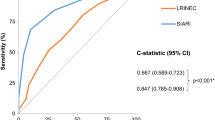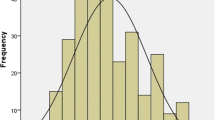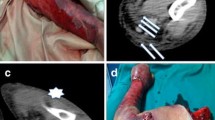Abstract
Objectives
To develop and validate a scoring system integrating MRI and laboratory findings to differentiate necrotizing fasciitis (NF) from non-necrotizing fasciitis (non-NF).
Methods
This retrospective study included 144 subjects who underwent surgery in one of three tertiary referral centers for NF or cellulitis with non-NF. The development cohort consisted of 96 subjects (NF = 47; non-NF = 49) from one center, and the validation cohort consisted of 48 subjects (NF = 23; cellulitis with non-NF = 25) from two different centers. The Laboratory Risk Indicator for Necrotizing Fasciitis (LRINEC) scoring system and five MRI findings (thickening of the intermuscular deep fascia ≥ 3 mm, extensive involvement of the deep fascia, multi-compartmental involvement in one extremity, presence of gas, and contrast-enhancement pattern) were included in univariate and multivariate logistic regression analysis to identify independent predictors of NF. An additive scoring system was developed using the coefficients of the final regression model. Model performance was assessed for discrimination and calibration. The scoring system was externally validated.
Result
The final scoring system consisted of three variables: thickening of the deep fascia ≥ 3 mm, multi-compartmental involvement, and LRINEC score. The new predictive model showed improved performance (area under the receiver operating characteristic curve [AUC], 0.862; positive and negative predictive values, 82% and 79%, respectively), compared with the LRINEC score alone (0.814, 77% and 67%, respectively). The model also showed good discrimination with the external validation dataset (AUC, 0.933).
Conclusions
Differentiation of NF from severe cellulitis with non-NF can be achieved with the new predictive scoring system.
Key Points
• The new predictive scoring system integrating two MRI findings with the LRINEC score can help in the differentiation of necrotizing fasciitis from severe cellulitis with non-necrotizing fasciitis.
• Thickening of the deep fascia ≥ 3 mm and multi-compartmental involvement were the most important MRI findings for the differentiation.






Similar content being viewed by others
Abbreviations
- AUC:
-
Area under the receiver operating characteristic curve
- CRP:
-
C-reactive protein
- LRINEC:
-
Laboratory Risk Indicator for Necrotizing Fasciitis
- MRI:
-
Magnetic resonance imaging
- NF:
-
Necrotizing fasciitis
- NPV:
-
Negative predictive value
- PPV:
-
Positive predictive value
- ROC:
-
Receiver operating characteristic
- WBC:
-
White cell count
References
Wong CH, Chang HC, Pasupathy S, Khin LW, Tan JL, Low CO (2003) Necrotizing fasciitis: clinical presentation, microbiology, and determinants of mortality. J Bone Joint Surg Am 85-A(8):1454–1460
Sarani B, Strong M, Pascual J, Schwab CW (2009) Necrotizing fasciitis: current concepts and review of the literature. J Am Coll Surg 208(2):279–288
Wong CH, Khin LW, Heng KS, Tan KC, Low CO (2004) The LRINEC (Laboratory Risk Indicator for Necrotizing Fasciitis) score: a tool for distinguishing necrotizing fasciitis from other soft tissue infections. Crit Care Med 32(7):1535–1541
Holland MJ (2009) Application of the Laboratory Risk Indicator in Necrotising Fasciitis (LRINEC) score to patients in a tropical tertiary referral centre. Anaesth Intensive Care 37(4):588–592
Sirikurnpiboon S, Sawangsangwattana T (2017) Early diagnosis of necrotizing fasciitis using Laboratory Risk Indicator of Necrotizing Fasciitis (LRINEC) score. J Med Assoc Thail 100(Suppl 1):S192–S199
Bechar J, Sepehripour S, Hardwicke J, Filobbos G (2017) Laboratory risk indicator for necrotising fasciitis (LRINEC) score for the assessment of early necrotising fasciitis: a systematic review of the literature. Ann R Coll Surg Engl 99:341–346
Swain RA, Hatcher JC, Azadian BS, Soni N, De Souza B (2013) A five-year review of necrotising fasciitis in a tertiary referral unit. Ann R Coll Surg Engl 95(1):57–60
Wilson MP, Schneir AB (2013) A case of necrotizing fasciitis with a LRINEC score of zero: clinical suspicion should trump scoring systems. J Emerg Med 44(5):928–931
Syed A, Alvin T, Fazrina A, Abdul R (2017) Determining if positive predictive value using Laboratory Risk Indicator for Necrotising Fasciitis is applicable in Malaysian patients with necrotising fasciitis. Malays Orthop J 11(2):36–39
Al-Hindawi A, McGhee J, Lockey J, Vizcaychipi M (2017) Validation of the laboratory risk indicator for necrotising fasciitis scoring system (LRINEC) in a Northern European population. J Plast Reconstr Aesthet Surg 70(1):141–143
Fernando SM, Tran A, Cheng W et al (2018) Necrotizing soft tissue infection: diagnostic accuracy of physical examination, imaging, and LRINEC score: a systematic review and meta-analysis. Ann Surg. https://doi.org/10.1097/SLA.0000000000002774
Malghem J, Lecouvet FE, Omoumi P, Maldague BE, Vande Berg BC (2013) Necrotizing fasciitis: contribution and limitations of diagnostic imaging. Joint Bone Spine 80(2):146–154
Kim KT, Kim YJ, Won Lee J et al (2011) Can necrotizing infectious fasciitis be differentiated from nonnecrotizing infectious fasciitis with MR imaging? Radiology 259(3):816–824
Brothers TE, Tagge DU, Stutley JE, Conway WF, Del Schutte H Jr, Byrne TK (1998) Magnetic resonance imaging differentiates between necrotizing and non-necrotizing fasciitis of the lower extremity. J Am Coll Surg 187(4):416–421
Fugitt JB, Puckett ML, Quigley MM, Kerr SM (2004) Necrotizing fasciitis. Radiographics 24(5):1472–1476
Rahmouni A, Chosidow O, Mathieu D et al (1994) MR imaging in acute infectious cellulitis. Radiology 192(2):493–496
Schmid MR, Kossmann T, Duewell S (1998) Differentiation of necrotizing fasciitis and cellulitis using MR imaging. AJR Am J Roentgenol 170(3):615–620
Ali SZ, Srinivasan S, Peh WC (2014) MRI in necrotizing fasciitis of the extremities. Br J Radiol 87(1033):20130560
Sullivan LM, Massaro JM, D'Agostino RB Sr (2004) Presentation of multivariate data for clinical use: the Framingham Study risk score functions. Stat Med 23(10):1631–1660
Egan JP (1975) Signal detection theory and ROC analysis. Academic Press, New York
Lemeshow S, Hosmer DW Jr (1982) A review of goodness of fit statistics for use in the development of logistic regression models. Am J Epidemiol 115(1):92–106
DeLong ER, DeLong DM, Clarke-Pearson DL (1988) Comparing the areas under two or more correlated receiver operating characteristic curves: a nonparametric approach. Biometrics 44(3):837–845
Cohen J (1968) Weighted kappa: nominal scale agreement with provision for scaled disagreement or partial credit. Psychol Bull 70(4):213–220
Neeki MM, Dong F, Au C et al (2017) Evaluating the laboratory risk indicator to differentiate cellulitis from necrotizing fasciitis in the emergency department. West J Emerg Med 18(4):684–689
Loh NN, Ch'en IY, Cheung LP, Li KC (1997) Deep fascial hyperintensity in soft-tissue abnormalities as revealed by T2-weighted MR imaging. AJR Am J Roentgenol 168(5):1301–1304
Acknowledgements
The authors thank Jung Bok Lee, Clinical Epidemiology and Biostatistics, University of Ulsan College of Medicine, Asan Medical Center, for his advice on statistical analysis.
Funding
The authors state that this work has not received any funding.
Author information
Authors and Affiliations
Corresponding author
Ethics declarations
Guarantor
The scientific guarantor of this publication is Hye Won Chung.
Conflict of interest
The authors of this manuscript declare no relationships with any companies, whose products or services may be related to the subject matter of the article.
Statistics and biometry
Jung Bok Lee, from Clinical Epidemiology and Biostatistics, University of Ulsan College of Medicine, Asan Medical Center, kindly provided statistical advice for this manuscript.
Informed consent
Written informed consent was waived by the Institutional Review Board.
Ethical approval
Institutional Review Board approval was obtained.
Methodology
• retrospective
• diagnostic or prognostic study
• multicenter study
Additional information
Publisher’s note
Springer Nature remains neutral with regard to jurisdictional claims in published maps and institutional affiliations.
Rights and permissions
About this article
Cite this article
Yoon, M.A., Chung, H.W., Yeo, Y. et al. Distinguishing necrotizing from non-necrotizing fasciitis: a new predictive scoring integrating MRI in the LRINEC score. Eur Radiol 29, 3414–3423 (2019). https://doi.org/10.1007/s00330-019-06103-0
Received:
Revised:
Accepted:
Published:
Issue Date:
DOI: https://doi.org/10.1007/s00330-019-06103-0




